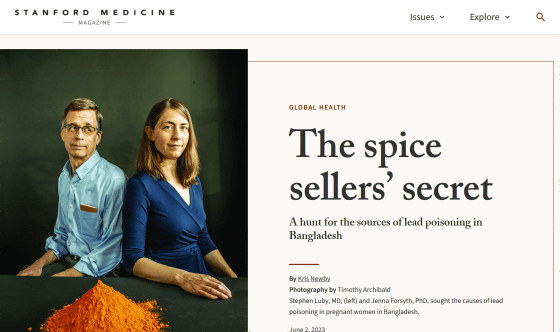A story until scientists find out that the cause of collective lead poisoning is ``a chemical substance that has been mixed in turmeric for 40 years to hide badly colored turmeric''

Turmeric's unexpected link to lead poisoning in Bangladesh
https://stanmed.stanford.edu/turmeric-lead-risk-detect/

Professor Stephen Ruby of Stanford University, who has been working on lead pollution problems around the world since the 1990s, announced in 2010, ``Pregnant women living in rural Bangladesh are contaminated with surprisingly high concentrations of lead.'' He read the research and started working on this problem. Mr. Ruby, who once contributed to the regulation of leaded gasoline in Pakistan, said, ``There is no safe level of exposure to lead.''
Lead is a toxic heavy metal, and lead poisoning can cause severe damage to the reproductive, nervous, and cardiovascular systems. The World Health Organization (WHO) has set the permissible upper limit of blood lead concentration to 5 μg (micrograms) per 100 ml, but one in three children living on the earth has lead contamination exceeding this upper limit. It is said that it is exposed. Lead poisoning has a lifelong adverse effect on cognitive ability, so the social and economic impact on the country can be severe.
It is estimated that between 24 and 46 million children and adolescents in Bangladesh have blood lead levels above this limit. Children with blood lead levels above the WHO limit have a 3-5 point lower score on intelligence tests and a higher risk of delinquency, violence and crime than children who are unaffected by lead. In Bangladesh, it is estimated that the IQ decline of the people due to lead poisoning causes a loss of 16 billion dollars (about 2.3 trillion yen) annually, which is 6% of the gross domestic product.

In 2015,
Mr. Ruby and Mr. Forsythe initially suspected that the source of the lead was a pesticide using lead arsenate (II) , but even after many days of research in the paddy fields, no evidence was found. did not.
However, based on the results of research on lead contamination in the same area, Mr. Forsythe speculated that ``turmeric,'' a spice that is deeply ingrained in the daily lives of Bangladeshis, may be the potential cause of lead contamination. rice field. Turmeric is used in a variety of applications, including curry, clothing dyes, cosmetics, medicines, and insect repellents. I can nod to be there.
Laboratory analysis of 17 turmeric samples brought back from Bangladesh by Forsyth found very high levels of lead and chromium in one of them. So Forsythe and his team visited Bangladesh again, interviewed turmeric producers, consumers, regulators, and others, and visited factories, wholesalers, and spice markets to find various turmeric and coloring agents. A sample was taken.
Turmeric is made from turmeric rhizomes, which are washed, boiled, dried, and crushed into small pieces. The 'color' of turmeric is a very important point for consumers, and turmeric with a brighter yellow color is traded at a high price, but turmeric with a bad color does not sell at a high price.
As a result of a survey by Mr. Forsyth et al., in Bangladesh, the practice of mixing turmeric with a lead-containing coloring agent called lead chromate (II) spread after the time when the color of turmeric deteriorated due to flooding in the 1980s. turned out to be This practice has been going on for 40 years, and most processors were unaware that lead chromate was toxic.

Contaminated turmeric and blood samples from people with lead poisoning were analyzed for lead isotope contrasts, confirming that turmeric was indeed the cause of lead poisoning. Turmeric mixed with lead chromate contained 500 times more lead than the Bangladesh legal limit of 2.5 μg per gram.
In 2017, Forsyth and colleagues shared their findings with the Bangladesh government. The Bangladesh government has a high awareness of the problem of lead contamination, and it seems that agricultural officials have been cooperating with Mr. Forsyth and others' research from the beginning. “Bangladesh has a very hospitable culture, people who are passionate about education and who really want to make this country better,” Forsythe said.
From September to December 2019, Stanford University and Bangladeshi authorities collaborated to conduct activities to raise awareness of the health hazards caused by coloring agents containing lead. Bangladesh's Prime Minister Sheikh Hasina covered the issue on state television, while the head of the food safety authority led soldiers to conduct a surprise market raid on turmeric sellers whose lead levels exceeded standards. There was also a performance of imposing a large fine on the spot.
As a result, as of September 2019, 47% of the turmeric on the market was contaminated, but in the first quarter of 2020, it plummeted to 5%, and lead-contaminated turmeric will be on the market in 2021. It is said that it was wiped out from. A blood test 16 months after the government intervention showed that the median blood lead level of the subjects had decreased by 30%.
Although the lead contamination of turmeric has calmed down, it has been confirmed that there is a group of 2 to 4 year old children with extremely high blood lead levels in Dhaka , the capital of Bangladesh, and the problem of lead contamination still exists. 'Lead is pervasive in our environment and its toxic effects are significant,' said Forsyth. 'That's why we need to continue to address this issue.'
Related Posts:







